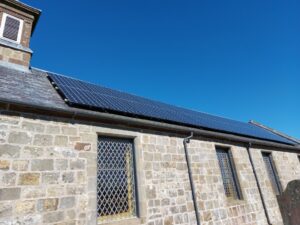Museums powering climate action
The heating, cooling, and powering of buildings contribute significantly to global emissions. Museums, often housed in older, energy-intensive buildings, encounter unique challenges but also have a remarkable opportunity to address these issues.
Lucy Neville, our Climate Officer, highlights examples of Scottish museums that are embracing renewable energy solutions and reducing their carbon footprint.


April 22nd is Earth Day and what better way to celebrate than by sharing the power of museums in taking Climate Action.
As a Climate Officer, my job can sometimes feel like endless spreadsheets and increasingly worrying reports about the state of nature and Climate Emergency. Never one for negativity however, I turn to my favourite part of the job – Scotland’s museums. There’s nothing I love more at work than jumping on the phone, or better yet bus, to a museum and hearing all about their incredible climate work.
I know some folk might be thinking “museums are great, but what do they really have to do with climate action?” Well, I’m glad you asked.
Museums are the beating hearts of our communities. They are the places where people meet friends, squeal with excitement on school trips, shelter from the rain, buy a last-minute birthday present for an Aunty, research their special interest, sometimes even go on a first date (it’s a whole building of conversation starters!). Museums are also holders of historic record. From the human and planetary impact of colonialism to weather records and geological evidence of climate trends – Scotland’s museums have it all. This unique combination of record keeping, scientific knowledge, artistic interpretation, trusted voices, and community means that museums can engage people at every stage of their Climate Emergency understanding and action.
This doesn’t just magically happen however; it takes work and Scotland’s museums are stepping up to the challenge. They are actively striving to engage the public with society’s need for systematic change. This includes creating risk registers to inform adaptation planning and advocacy, enhancing the biodiversity of their local areas, showcasing climate justice, and working to reduce their own carbon footprints. Museums Galleries Scotland has been proud to support this work. Between 2020 and 2023, we funded 81 projects with over £3 million towards energy efficiency and renewable energy in the sector.
This year’s Earth Day theme is Our Power, Our Planet, so I thought I’d share a small selection of the many museums embracing renewable energy.

People might laugh when you tell them Scotland is perfect for solar power, after all we’re famous for our rain. However, the long daylight hours in summer make it ideal for photovoltaic (PV) solar panels, which convert light—not heat—into electricity. Several of Scotland’s museums have embraced PVs from the Grampian Transport Museum in Aberdeenshire to Thirlestane castle in the Scottish Borders. Many, like CrawfordJohn Museum in South Lanarkshire and Bennie Museum in West Lothian have paired their panels with batteries meaning they can store the electricity generated for when its most needed. This approach not only improves energy efficiency but also greatly reduces bills.
Others, such as Gairloch Museum, have taken the approach of selling unused electricity generated to the National Grid creating an additional income stream for their organisation. Gairloch Museum has also added a digital display in the building’s reception for visitors and staff to see the electricity generation and use in real time, adding a crucial element of public engagement to their renewable energy project. The Glenfinnan Station Museum has taken this initiative one step further and is currently building a Climate Emergency exhibition inside a disused snowplough, which will be powered by solar panels installed on its roof!

Sadly, we don’t have the beautiful long summer days all year round. Whilst there is still enough light to justify solar panels, incorporating additional renewable energy sources can make the system more robust. For example, Ness Heritage Centre on Na h-Eileanan Siar and the Museum of Islay Life have both successfully combined the power of air source heat pumps with solar panels to ensure year-round energy production.
Air source heat pumps convert the outside air into heat which can be fed into a building’s heating system. Amazingly, they can still draw heat from the air even temperatures drop below freezing. Heat pumps are often slim lined and easier to gain planning permission for than solar panels. This makes them the perfect option for floating museums, such as The Tall Ship at Riverside in Glasgow, which had an air source heat pump installed in 2022 with support from MGS funding.
It’s not just from the air that heat can be extracted though, the ground beneath our feet also holds vast amounts of heat. Geothermal activity, originating from the Earth’s core, can be extracted through deep bore holes in energy plants. It can also be less intrusively accessed for less intense heat through ground source heat pumps. Lismore Gaelic Heritage Centre have tapped into this energy source for year-round heating, regardless of the weather. They’ve also insulated the roof with sedum, providing a space for nature in the process.
Heat can also be extracted from seas, rivers, and lochs. The Museum of Lead Mining in Wanlockhead was one of the first places in Scotland to trial a new development in this technology. Using the gravity of the hill to pull water down into the system, not dissimilar to the way the site has been used for gold panning in the past, the heat exchanger pulls heat from the water and transfers it to the museum’s heating system.
Embracing new technology in renewables is happening across Scotland’s museums, reducing bills, generating income, engaging the public, and giving this Climate Officer a little bit more climate optimism. You can explore more examples of climate action from museums across Scotland in our advice guide.